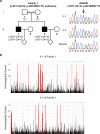A novel splicing variant in DNAH8 causes asthenozoospermia
- PMID: 33611675
- PMCID: PMC8266938
- DOI: 10.1007/s10815-021-02116-1
A novel splicing variant in DNAH8 causes asthenozoospermia
Abstract
Purpose: To identify the genetic factors responsible for asthenozoospermia, which is a major cause of male infertility characterized by immotile and malformed spermatozoa.
Methods: Whole-exome sequencing was performed in two brothers from a family with asthenozoospermia to identify pathogenic variants. The functional effect of the identified variant was investigated in HEK293T cells using a minigene assay.
Results: We identified a novel homozygous splicing variant c.6311-2A>G in DNAH8 from two affected brothers belonging to the same consanguineous family. The splicing variant altered a consensus splice acceptor site of DNAH8 intron 44, which led to the deletion of exon 45 and resulted in a frameshift and a predicted truncated protein (p.G2104Efs*19). Although most spermatozoa from the patients presented with reduced sperm motility, intracytoplasmic sperm injection was able to overcome the inability of the spermatozoa to reach the ovum and thus produce a healthy child for the proband.
Conclusions: This finding expands the mutational spectrum of DNAH8, making it a potential genetic diagnostic marker for those suffering from primary male infertility.
Keywords: Asthenozoospermia; DNAH8; Male infertility; Variant.
Conflict of interest statement
The authors declare no competing interests.
Figures


Similar articles
-
Loss-of-function mutation in DNAH8 induces asthenoteratospermia associated with multiple morphological abnormalities of the sperm flagella.Clin Genet. 2020 Oct;98(4):396-401. doi: 10.1111/cge.13815. Epub 2020 Jul 30. Clin Genet. 2020. PMID: 32681648
-
A homozygous ARMC3 splicing variant causes asthenozoospermia and flagellar disorganization in a consanguineous family.Clin Genet. 2024 Oct;106(4):437-447. doi: 10.1111/cge.14575. Epub 2024 Jun 21. Clin Genet. 2024. PMID: 39221575
-
Bi-allelic DNAH8 Variants Lead to Multiple Morphological Abnormalities of the Sperm Flagella and Primary Male Infertility.Am J Hum Genet. 2020 Aug 6;107(2):330-341. doi: 10.1016/j.ajhg.2020.06.004. Epub 2020 Jul 2. Am J Hum Genet. 2020. PMID: 32619401 Free PMC article.
-
A novel variant in CFAP69 causes asthenoteratozoospermia with treatable ART outcomes and a literature review.J Assist Reprod Genet. 2023 Sep;40(9):2175-2184. doi: 10.1007/s10815-023-02873-1. Epub 2023 Jul 1. J Assist Reprod Genet. 2023. PMID: 37392306 Free PMC article. Review.
-
Genetic underpinnings of asthenozoospermia.Best Pract Res Clin Endocrinol Metab. 2020 Dec;34(6):101472. doi: 10.1016/j.beem.2020.101472. Epub 2020 Nov 6. Best Pract Res Clin Endocrinol Metab. 2020. PMID: 33191078 Review.
Cited by
-
Novel mutations in LRRC23 cause asthenozoospermia in a nonconsanguineous family.Asian J Androl. 2024 Sep 1;26(5):484-489. doi: 10.4103/aja202435. Epub 2024 Jul 26. Asian J Androl. 2024. PMID: 39054792 Free PMC article.
-
A novel homozygous frameshift variant in DNAH8 causes multiple morphological abnormalities of the sperm flagella in a consanguineous Pakistani family.Asian J Androl. 2023 May-Jun;25(3):350-355. doi: 10.4103/aja202274. Asian J Androl. 2023. PMID: 36308074 Free PMC article.
-
Epigenetic Alterations in Cryopreserved Human Spermatozoa: Suspected Potential Functional Defects.Cells. 2022 Jul 4;11(13):2110. doi: 10.3390/cells11132110. Cells. 2022. PMID: 35805194 Free PMC article.
-
Diagnostics and Management of Male Infertility in Primary Ciliary Dyskinesia.Diagnostics (Basel). 2021 Aug 26;11(9):1550. doi: 10.3390/diagnostics11091550. Diagnostics (Basel). 2021. PMID: 34573892 Free PMC article. Review.
-
Splicing Mutation in DNALI1 Causes Male Infertility with Severe Oligoasthenoteratozoospermia in Humans.Reprod Sci. 2024 Jun;31(6):1610-1616. doi: 10.1007/s43032-023-01451-1. Epub 2024 Jan 11. Reprod Sci. 2024. PMID: 38212584
References
-
- WHO . Examination and processing human semen. New York: Cambridge University Press; 2010.
-
- Beurois J, Martinez G, Cazin C, Kherraf ZE, Amiri-Yekta A, Thierry-Mieg N, Bidart M, Petre G, Satre V, Brouillet S, Touré A, Arnoult C, Ray PF, Coutton C. CFAP70 mutations lead to male infertility due to severe astheno-teratozoospermia. A case report. Hum Reprod. 2019;34(10):2071–2079. doi: 10.1093/humrep/dez166. - DOI - PubMed
MeSH terms
Substances
Grants and funding
LinkOut - more resources
Full Text Sources
Other Literature Sources
Medical
Molecular Biology Databases

